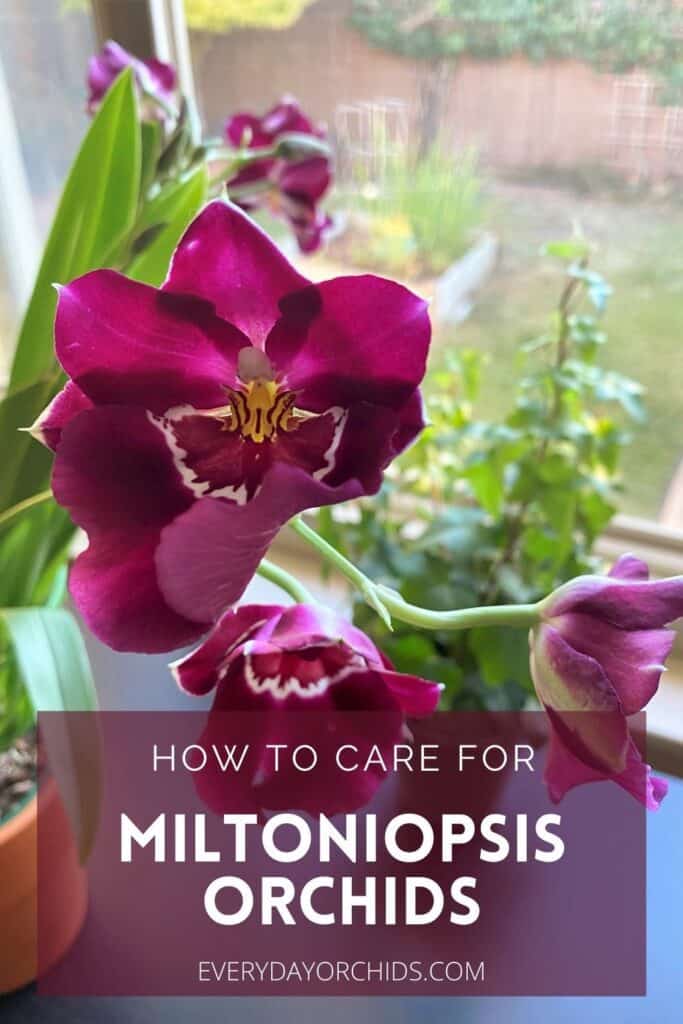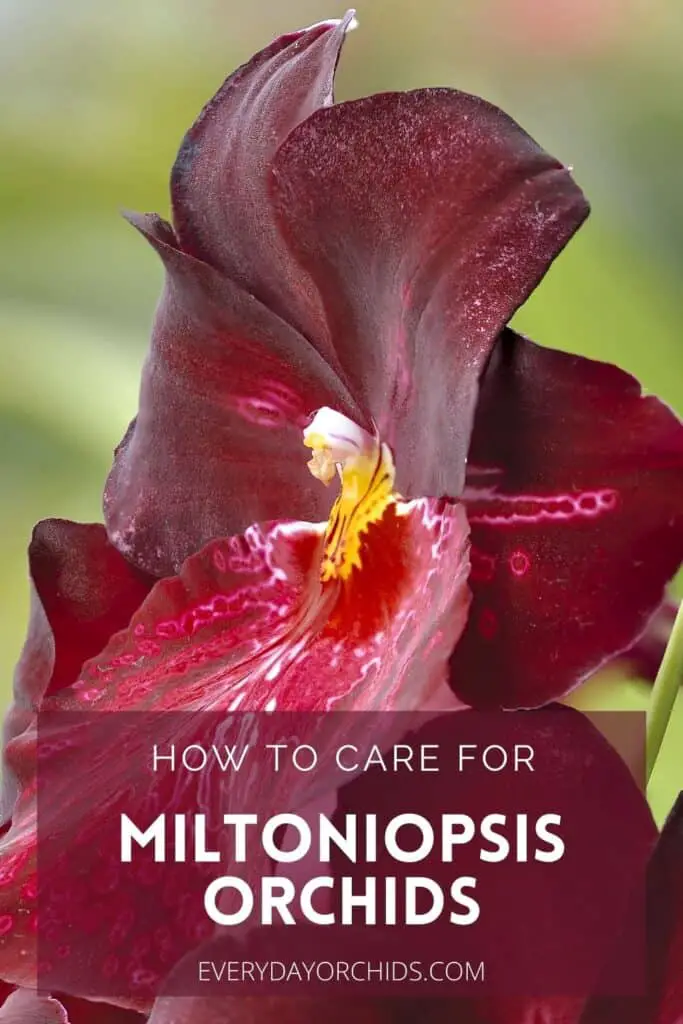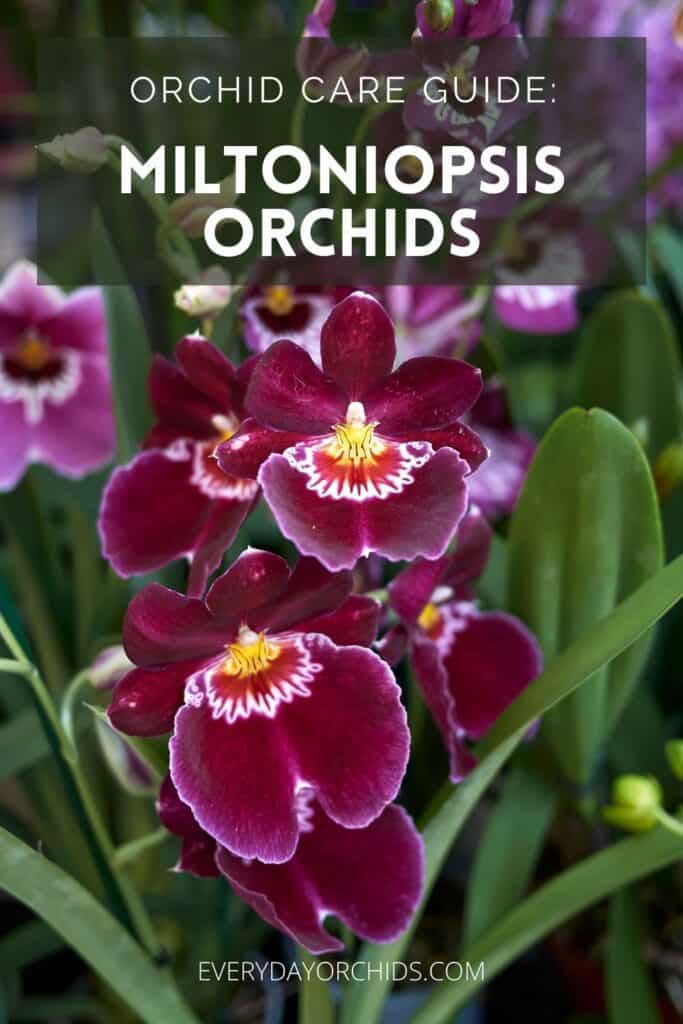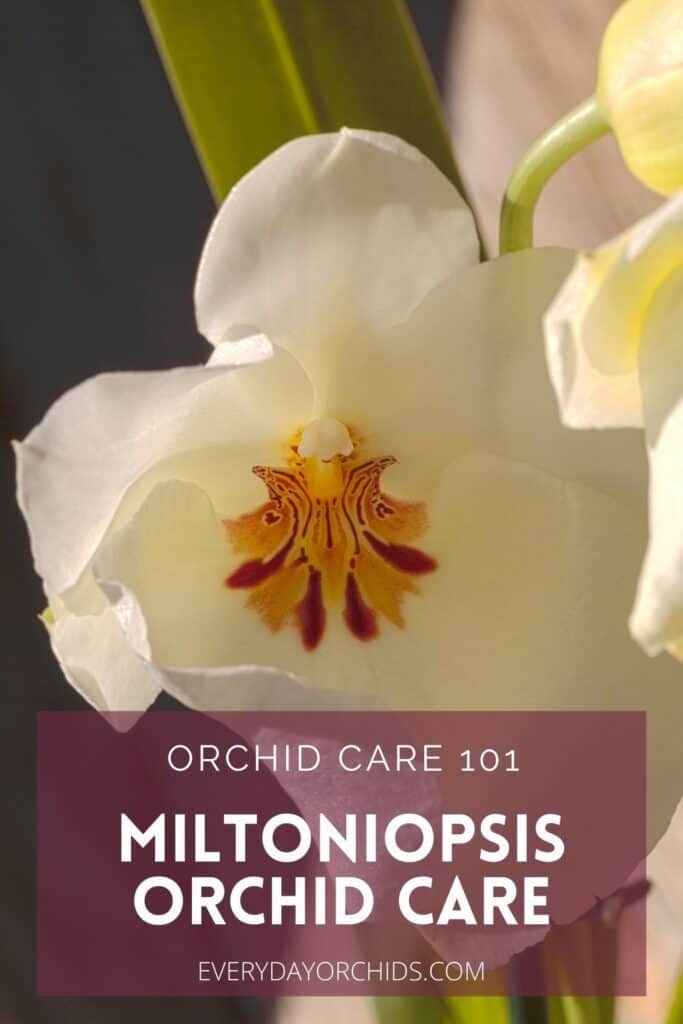Miltoniopsis orchids are a wonderful orchid to add to your collection, but do you know how to care for them? This orchid’s care needs are quite unique and may be very different than the care you normally give your other orchids.
Don’t worry though. I’ll go over what you need to know about growing Miltoniopsis orchids in this care guide. Even if you feel like you don’t know what to do, by the end of this article, you should feel very comfortable caring for your new Miltoniopsis orchid.
Miltoniopsis orchids have several basic care needs. These are cool-growing, low-light orchids. They require 50-70% humidity levels and enough watering throughout the year to keep their soil evenly moist. Fertilize lightly with a diluted orchid fertilizer once a month.
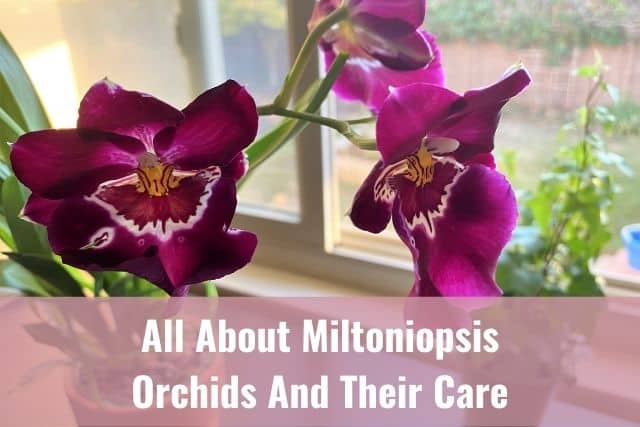
Miltoniopsis orchids are also known as “pansy orchids.” Their beautiful, delicate flowers resemble garden pansies. If you have one of these orchids, congratulations on snagging one of these unique orchids! Keep reading and I’ll go over the care needs of Miltoniopsis orchids in more detail below.
Please note that these links are affiliate links and as an Amazon Associate, I earn from qualifying purchases. Purchases made through affiliate links in this post may generate commissions at no additional cost to you. Use this link for a discounted Amazon Prime trial. Thank you for your support!
Table of Contents
What Is The Difference Between Miltonia and Miltoniopsis Orchids?
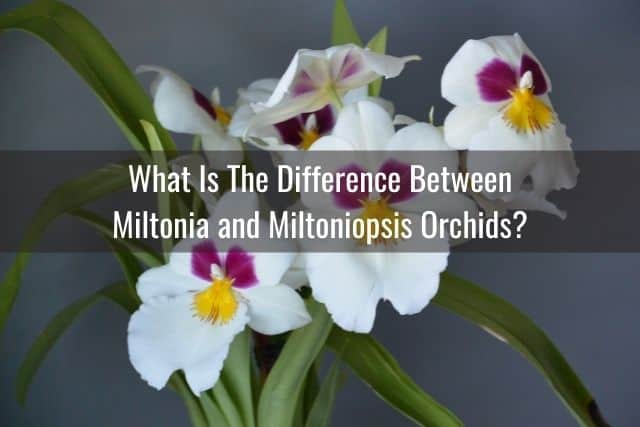
Miltoniopsis orchids often get mistaken for Miltonia orchids and vice versa. Some people mistakenly use these names interchangeably. However, there are some distinct differences between the two orchid varieties.
Please know that they are not the same orchid and they have very different care needs. You don’t want to mistakenly give your Miltoniopsis orchid the growing conditions for a Miltonia orchid. Then you’ll wonder why your orchid isn’t thriving or blooming!
Here are some key differences to help you know which kind of orchid you have:
Miltoniopsis orchid flowers resemble pansies. Miltonia orchid flowers look more like Odontoglossum orchid flowers. If your orchid flowers look like garden pansies, it is likely a Miltoniopsis orchid.
Miltoniopsis orchids have one leaf on either side of the pseudobulb. Miltonia orchids have two leaves on each side of the pseudobulb.
The pseudobulbs of Miltoniopsis orchids are flatter and are arranged in close clusters. Miltonia orchid pseudobulbs are rounder and more spaced apart.
Leaves of the Miltoniopsis are a darker gray-green, while leaves of the Miltonia orchid are a lighter bright green.
Miltoniopsis orchids are native to Ecuador and Venezuela, while Miltonia orchids are more commonly found in Brazil.
More importantly, Miltoniopsis orchids are considered cool-growing orchids and require lower growing temperatures. Miltonia orchids are warm-growing orchids and can tolerate higher growing temperatures.
Miltoniopsis Orchids And Their Blooming Seasons
Generally, Miltoniopsis orchids will bloom in the spring. The blooming season usually lasts from April to July. Some species can bloom multiple times a year. Other species will bloom in the fall.
Dormancy lasts for a brief period from the end of the blooming season in July to late August. Then, the Miltoniopsis orchids start their growth period in late August or early September.
A Miltoniopsis orchid can grow multiple flower stems, either from the top or sides of the pseudobulb. Each stem will have 4 to 10 flowers on it. The flowers themselves span several inches across.
Miltoniopsis orchid flowers can last anywhere from 4 to 6 weeks before falling off.
These Orchids Have A Scent!
Miltoniopsis orchid flowers are scented. Their floral scent is similar to a light, rose-scented perfume.
Blooming Problems
If your Miltoniopsis orchid is failing to bloom, there could be several reasons for this.
One, it may be too warm. Remember, these are cool-growing orchids. Warm or hot temperatures will prevent blooming from happening. To help your Miltoniopsis orchid flower each blooming season, make sure you keep temperatures within their preferred range.
Second, it may be too dry. These orchids grow in the cloud-covered forests, an environment with high levels of humidity. Check your humidity levels using a hygrometer. If you find that humidity levels in your orchid growing area are too low, then you will need to somehow add humidity for your orchids. You can do this using a humidifier, humidity tray, or a greenhouse.
Third, your orchid may not be getting enough light. You can tell if your orchid needs more light if the leaf color is a dark green shade. You can read more about how much light an orchid needs here.
If your home just does not get much natural light, you can consider setting up artificial lighting for your orchid. If you do so, just position your Miltoniopsis orchid a little further away from the lightbulb until you know how your orchid tolerates it.
Temperature Requirements
These orchids will do well in most household settings and are considered cool-growing orchids.
Their ideal daytime temperature ranges from 70 to 80 degrees Fahrenheit, while their ideal nighttime temperatures range from 50 to 60 degrees Fahrenheit.
Conveniently, this is the temperature range in most households, which makes it easier to accommodate a Miltonioposis orchid’s temperature needs.
Lighting Needs of Miltoniopsis Orchids
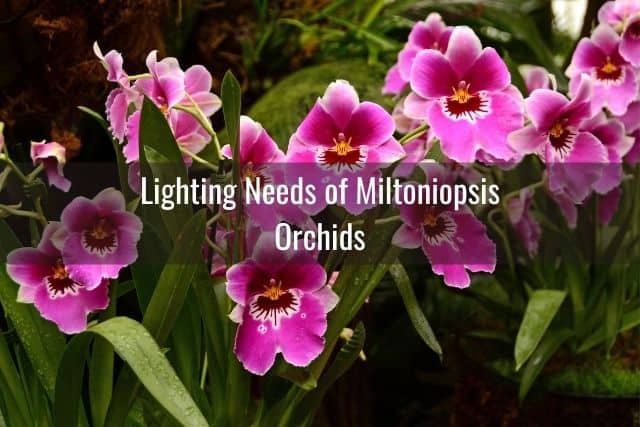
Filtered, shaded light is best for this orchid. These orchids grow in the jungle, under the shade of a tree canopy.
These are low-light orchids, so about 1000 to 2000 foot candles of light is best. While bright, indirect light is still needed to help these orchids grow, the lighting should not be too intense or strong.
You’ll know if your Miltoniopsis orchid is getting the right amount of sunlight based on the leaf color. Ideally, the leaf should be a light green color. Too much light and the leaf color will trend towards yellow. Too little light and the leaf color will be a medium to dark green color.
Avoid exposing your orchid to direct sunlight. Miltoniopsis orchids burn easily and direct sunlight will quickly damage the delicate orchid leaves.
Place your orchid near an east-facing window, where it can benefit from the soft morning light.
Watering Needs
Unlike other orchids, which may need a resting period during the winters, Miltoniopsis orchids will need to be watered throughout the year. The frequency of watering will change depending on the season.
In general, watering your Miltoniopsis orchid once a week should be sufficient. In warmer weather, your orchid may need more frequent watering, such as twice a week.
Don’t allow the orchid potting media to dry out completely. Instead, keep the potting media evenly moist.
When you water your Miltoniopsis orchid, water it in the morning deeply with a good soaking. Place the orchid pot into a bucket of luke-warm water for at least 10 minutes. Use water that is free of minerals and other such deposits. Then, allow the water to drain out completely. Empty out any saucers under the orchid pots and avoid having your orchid pot sit in standing water.
If the leaves start to wilt, or form accordion-like pleats, this is a sign that the orchid needs more water. Similar to how Phalaneopsis leaves may twist and curl, accordion pleating of Miltoniopsis leaves is, unfortunately, irreversible.
Wrinkled pseudobulbs are a more advanced sign of inadequate watering, so pay close attention. A healthy Miltoniopsis orchid will have firm, smooth pseudobulbs without wrinkles or rot. There is a fine line between potting media that is evenly moist and potting media that is overly wet. Overly wet potting media can lead to rot. Watch out for this.
Fertilizing Miltoniopsis Orchids
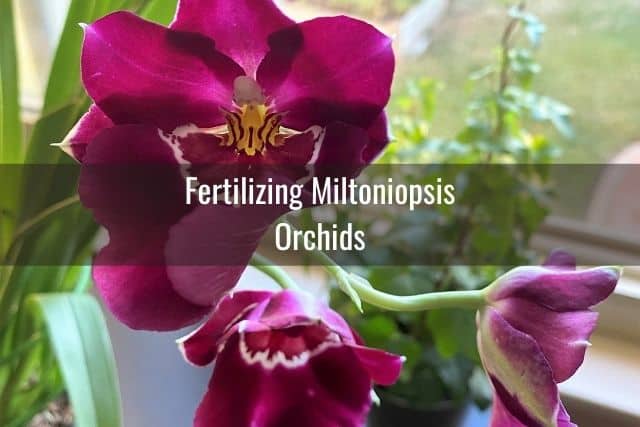
Miltoniopsis orchids have delicate roots and need a relatively weak orchid fertilizer to avoid root burn.
Use an orchid specific fertilizer with a 10-10-10 NPK ratio. Prepare the fertilizer according to the product instructions. Then, dilute it with 3 parts more water to make it quarter-strength. I go over how to do this in more detail in my article on how to fertilize your orchid.
These orchids do not need frequent feedings. You can fertilize your Miltonia orchid once a month or once every other week as needed.
These orchids have little tolerance for salt and mineral build-up, so after every fourth fertilization, run water through the orchid pot and potting media to rinse out any residue build-up.
In late winter or early spring, you can fertilize with a bloom booster orchid fertilizer. This will help your orchid produce more blooms come spring.
Humidity Requirements
The Miltoniopsis orchids are originally from the cloud-covered forests of of South America. As you can imagine, in their native environment, they are surrounded by shade and high levels of humidity.
Miltoniopsis orchids prefer 50 to 70% humidity. Proper humidification is essential for your Miltoniopsis orchids to grow and thrive. Insufficient humidity can weaken and stress your orchid, making it vulnerable to orchid pests such as spider mites.
You can use a hygrometer to track humidity levels. There are some hygrometers that can even record the 24-hour humidity and temperature range. The ThermoPro digital hygrometer helps me measure both humidity and temperature levels around my orchids and I couldn’t recommend it more.
I personally use a cool-mist humidifier to humidify the space around my Miltoniopsis orchid. I track humidity levels using my hygrometer and turn the humidifier on or off as needed to stay within the 50 to 70% humidity range.
You can also set up a humidity tray and place your orchid pot on top. There are many ways to increase humidity around your orchids. These are just two of my favorite methods that I use to provide humidity for my orchids.
Along with maintaining high humidity, make sure you have good air movement around your orchid. Set up a small fan near your orchids if needed. This will help prevent fungi and bacterial growth on your orchid.
Roots and Repotting Miltoniopsis Orchids
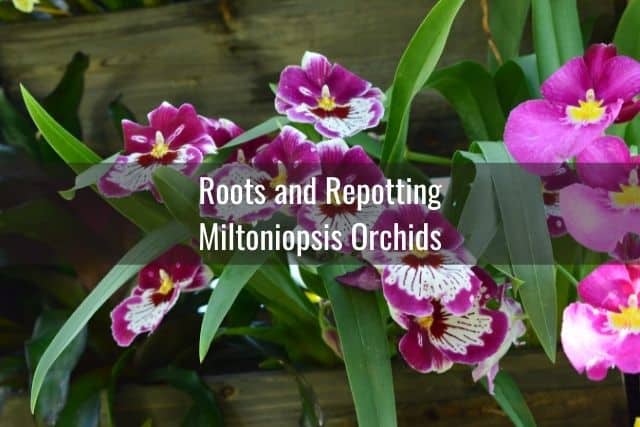
Typically, Miltoniopsis orchids will need to be repotted once a year. The exception to this rule would be if you notice that the orchid potting media is rotting, decomposing, or showing signs of mold or other disease. In this case, repot your orchid immediately and don’t wait.
Otherwise, for routine repotting, you should wait until after the blooming season is done and when new growth is starting. This means the best time to repot your Miltoniopsis orchid is late summer or early fall.
Repotting while the orchid is in bloom could cause the flowers to fall off early. Fall is when the growth season starts up again and the orchid begins to grow new roots and leaves.
Using a well-draining orchid potting media is essential. As I went over in the watering section above, this orchid prefers its potting media to be evenly moist. However, good drainage and air circulation around the roots will help prevent rot.
Miltoniopsis orchid roots are fine, thin, and fragile. These roots are very similar to the roots of Epidendrum and Oncidium orchids. When choosing an orchid potting mix, select a fine-grade mix made for epiphyte orchids. You can also use a combination of sphagnum moss and orchid potting media.
Miltoniopsis orchids like to spread out. When repotting, they will do well in shallow, wide orchid pots rather than deep orchid pots. Do not center the orchid into a new pot when repotting. Instead, position it off to one side, with the newer growth pointing out towards the center of the pot. This will give the orchid room to spread out and grow more pseudobulbs.
Pests and Disease
Some of the most common pests that plague Miltoniopsis orchids include scale, aphids, and spider mites. Low humidity levels can attract spider mites to set up house in your Miltoniopsis orchid. Aphids may be attracted to the sap in flower spikes during the blooming season.
You can read more here about orchid pests and how to get rid of them.
There are a variety of ways you can get rid of pests. Aside from using insecticides and pesticides, you can also use natural and organic methods. For example, use Neem oil to combat these orchid pests without using chemicals or toxic materials. Make sure you provide your orchid with adequate humidity levels to discourage spider mites from infesting your orchid.
Propagating More Miltoniopsis Orchids
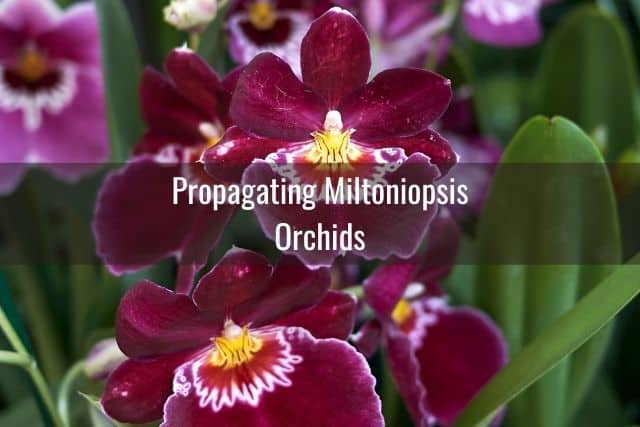
Propagation of Miltoniopsis orchids is achieved through pseudobulb division. It is best to wait until you have at least six pseudobulbs present before you start dividing your orchid.
These orchids are sympodial orchids, meaning that new growth forms from the rhizome of a older growth, or pseudobulb. As the new growth, or pseudobulb forms, it can grow its own flower spikes and send out rhizomes to develop additional pseudobulbs. It may take at least a year or two of growth before your orchid has enough pseudobulbs present for propagation.
Once your orchid is ready, unpot your orchid and gently rinse off the old potting media. Using a sterilized blade, cut through the rhizome below the soil line, dividing the orchid into sections. Make sure there are at least three pseudobulbs per section.
Then, pot each section into a new orchid pot with fresh orchid potting media. Cover the new growth with a maximum of 1/2-inch worth of orchid potting media. Burying them too deep into the pot would increase their risk for rot.
For more information and a detailed step-by-step guide, check out this resource on how to propagate orchids.
Final Thoughts
Miltoniopsis orchids are gorgeous orchids and a welcome addition to any orchid collection. While they will require more care and attention than a beginner orchid, such as a Phalaenopsis orchid, they are not impossible to care for. Once you are familiar with their specific care needs, you can tailor your growing environment to match them. Best of luck growing and caring for your Miltoniopsis orchid. I hope this has helped!
If you enjoyed this article, please pin it and share!
